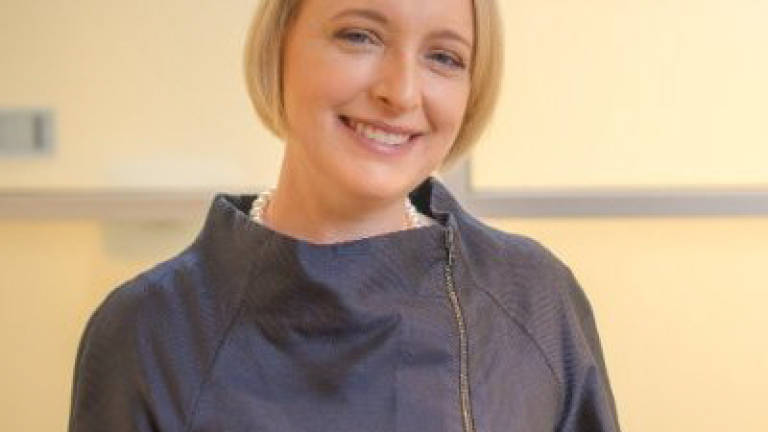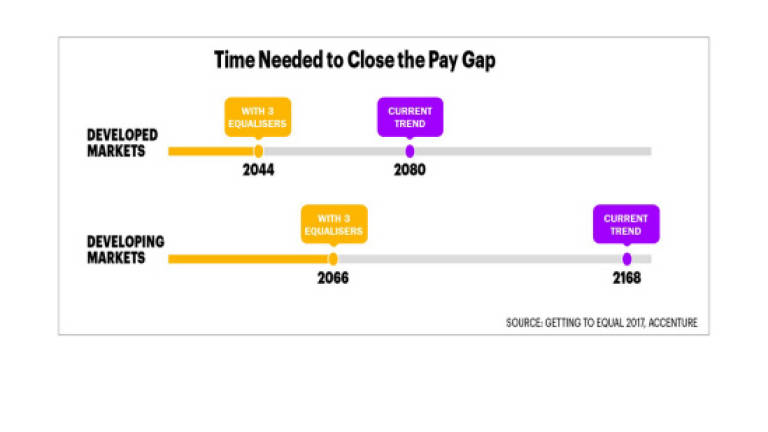Closing the gender pay gap



BASED on current trends and lifestyles, the pay gap between men and women in the workforce in developing markets will not close until the year 2168. Ladies, that is a long time to wait, no? Then again, as women are part of society and affect every part of the “system” itself, men will also be affected in some way or other as life and the world revolves around both genders.
That said, theSun runs by the report by Accenture – Getting to Equal 2017, where its chairman and CEO Pierre Nanterme, and its North America CEO Julie Sweet, urge society to collaborate to close the gap together.
GETTING TO EQUAL FASTER
“Gender equality is an essential element of an inclusive workplace, and this extends to pay. Business, government and academia all have an important role to play in closing the gap. Collaboration among these organizations is key to providing the right opportunities, environments and role models to lead the way for change,” Nanterme states while Sweet echoes similar sentiments. “The future workforce must be an equal workforce. The gender pay gap is an economic and competitive imperative that matters to everyone, and we must all take action to create significant opportunities for women and close the gap more quickly,” she says.
The new research disclosed that women graduating from university in developed markets in 2020 could be the first generation to close the gender pay gap in their professional lifetimes. To aid in narrowing this gap in developed markets by 2044 or reaching pay parity in developing markets by 2066 instead of 2168, women are urged to take advantage of three career equalisers, of which businesses, governments and the academia/educational institutions must provide support.
According to the global research, a woman earns an average of US$100 for every US$140 a man earns. What adds to the imbalance is the fact that women are less likely to have paid work than men in some countries, 50% and 76% respectively. This causes a further imbalance which contributes to a “hidden pay gap” that increases the economic inequities between men and women, resulting in for every US$100 a woman takes home, a man gets US$258, the research shows.
Says Accenture’s growth markets managing director Karina Gan: “The future workforce must be an equal workforce. The gender pay gap is an economic and competitive imperative that matters to everyone, and we must all take action to create significant opportunities for women and close the gap more quickly.”
RESTORATIVE SOLUTION
To help women in the workforce close the gender pay gap, Accenture’s 2016 report suggests:
▶ women further educate themselves in digital fluency so as to use digital technologies to connect, learn and work more efficiently in the workforce;
▶ women establish a career strategy for themselves – aim high, make more informed choices and manage their careers more proactively; and
▶ women should immerse themselves even more in technology and gain the opportunity to acquire greater technology know-how and stronger digital skills in order to advance as quickly as their male colleagues.
The report found that women in Malaysia are actually well positioned to activate the three equalisers considering the country’s high digital adoption rates. It also found that women here do use a substantial amount of digital technology especially in shopping, banking, making bookings (tickets and reservations etc.) besides being active on social media sites, and 31% of Malaysians (both men and women included) have started their own online business.
Respondents of the report also found that although 80% of Malaysians believed that acquiring digital skills was important in advancing their future career, less than 52%of women were continuously learning new digital skills (men stood at 62%). Women need to take the opportunity to upskill their digital technology prowess in order to boost their income to US$3.9 trillion worldwide.
“Gender equality is an essential element of an inclusive workplace. And this extends to pay,” said Nanterme. “Business, government and academia all have an important role to play in closing the gap. Collaboration among these organisations is key to providing the right opportunities, environments and role models to lead the way for change,” he added.
WHY CLOSE THE GENDER PAY GAP?
▶ It benefits employers and workers;
▶ Brings greater profitability to economies as a whole; and
▶ Promotes social justice and equal opportunities.